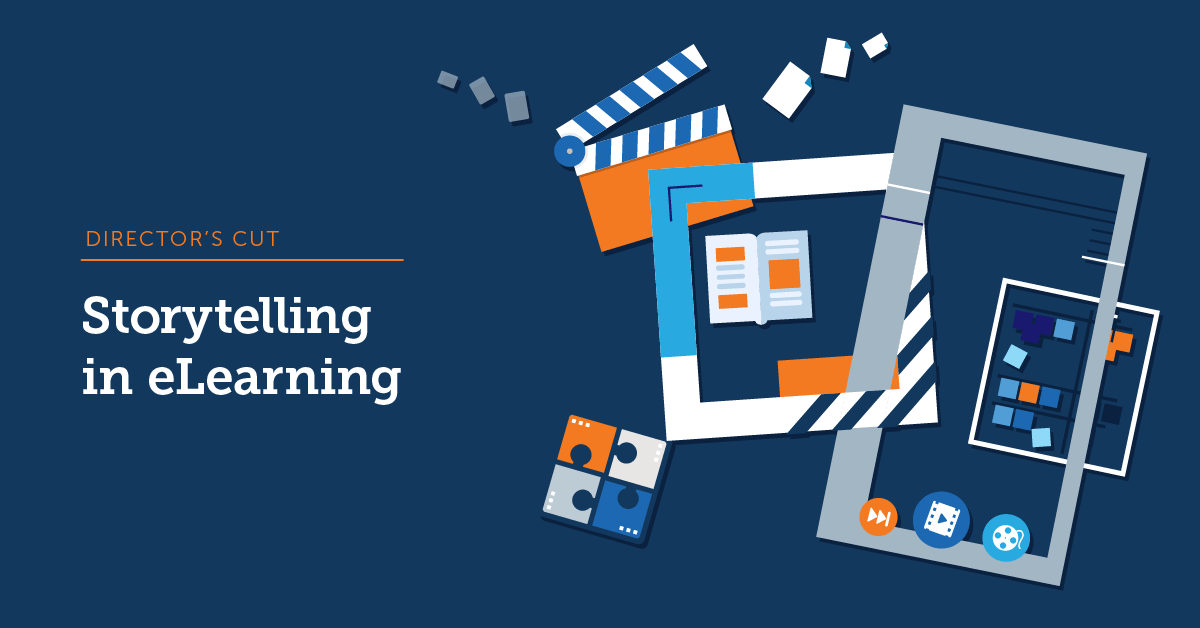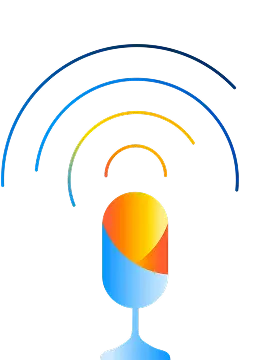Duration: 35 minutes
Season 1
Episode 3
Power up training with
interactive content design
How can we make sure employees are active and engaged during training? It’s time to elevate our learning game. We talk with Karl Kapp, Gamification and Instructional Design expert, professor at Bloomsburg University, and TEDx speaker.
Karl reveals the secrets behind crafting effective, meaningful, and interactive content design for businesses big and small. From storytelling to escape rooms, get ready to create all-round enjoyable learning experiences!
Key takeaways:
Action-first learning is an amazing way to grab the learners’ attention from the very beginning. And this happens before they even start their training. Why? Adult learners learn best when they are aware they don’t know something. So first, it’s important to create a learning moment for them. Then, follow it up with the necessary training.
It’s crucial to clarify the purpose behind training. Then, explain the training context and the expected outcome for the business and the team or individual. This way, participants can better understand the value and relevance of their training.
People need to be trained in a safe interactive environment to make mistakes and learn from them. If not, they end up making errors while dealing with customers, products, and colleagues. These situations are not ideal for learning from mistakes.
People learn and retain facts better in a story than in a bulleted list. Stories create multiple pathways. They create a visceral feeling, factual knowledge, and sometimes evoke other senses like smell or taste. Of course, storytelling is not the best thing to use in all cases, but if we want people to learn how to treat customers correctly, or how to work with peers, then stories become a really powerful driver. Plus, stories are a big element of gamification.
Balancing the entertainment aspect and the learning objectives can be challenging. So, to make gamification work, for example, it’s crucial to look beyond the extrinsic motivators (i.e. points, badges, and leaderboards.) You should look at meaning, purpose, and feedback so that interactive learning can be valuable.
Smaller organizations don’t have to be daunted by extensive learning budgets. It’s all about embracing a design philosophy and posing questions rather than a need for advanced technology. Meaning, you don’t have to design and create a game from scratch!

Karl Kapp, Ed.D
About our guest:
Scholar, writer, and expert on the convergence of learning, technology, and business with a focus on game-thinking. Karl is an award-winning professor and author of eight books including “Play to Learn”.
Karl has been a TEDx speaker, international keynoter, and has won numerous awards, including being named one of LinkedIn’s Top Voices in Education.
Share episode
Want more resources on this topic?

How to develop a highly interactive online training program

Game on: 5 examples of gamification in corporate training

How to master the art of video storytelling in virtual training
More episodes we think you’ll love

What are the 3 power skills every professional needs for the future? How do the human skills employees build in their personal lives benefit the workplace? Educational expert and author Dr. Michelle Weise explains how rapid technological innovation is demanding a change in the way we approach learning and work.
Go to episode
How can L&D overcome the 3 biggest challenges facing companies today? Why’s L&D failing to get approval from the C-suite? Dr. Keith Keating, the award-winning author of “The Trusted Learning Advisor” joins us to answer these questions.
Plus, we cover how to create a culture where L&D’s value isn’t just a number, and the critical importance of positioning yourself one step ahead of tech trends.
Go to episode
What are the 5 key elements of relevant training? And what’s the 1 training metric that could lose L&D pros their jobs? In this episode we invite L&D consultant, Instructional Designer, and fellow podcaster, Dr. Heidi Kirby to share her experience and give us actionable advice on course creation.
Go to episode
Never miss an episode! Get every new drop right in your inbox
By clicking the Subscribe button, you accept and consent to receive the type of content mentioned above. Please review the TalentLMS Privacy Policy for further information.
Full Episode Transcript
Host: On this episode of Keep It Simple, we’re demystifying interactive content design with Karl Kapp, professor of Instructional Design at Bloomsburg University, Pennsylvania. He’s been researching the topic for the past two decades and has written books on everything from microlearning to gamification and advised dozens of companies on their learning systems. He’s also been authoring learning courses for LinkedIn since way back when it was called Linda. I’m really excited to speak to him today about the importance of getting the balance right between fun and effective training content. How Instructional Designers can avoid making things too interactive. And why big budgets and technical expertise aren’t always necessary when it comes to stepping up your training programs. Stay with us.[00:02:30]
Host: Hi, Karl. How are you? [00:02:32]
Karl Kapp: Hi, I’m doing well. How are you doing? [00:02:33]
Host: I’m doing great. Thank you so much for asking and even more for being here with us today. I’d love to hear your perspective of who you are, how you got here. I know you were a teacher before. [00:02:36]
Karl Kapp: So actually, yes. So technically, I guess I still am as a professor of instructional technology at Bloomsburg University. But my career really has been about thinking about, studying and researching, engaging, learning events. And that’s kind of manifested itself. Mainly in gamification and game-based learning. So a number of years ago, I was, you know, playing a video game and was like, wow, this is so engaging. And it was right when eLearning was coming online. [00:03:00]
And eLearning is so not engaging. What’s the way that I can kind of combine the two so that eLearning can be more engaging? And so that kind of started my journey. And then I discovered the word gamification. It was coined in about 2002. I’m like, Oh, that’s the great word. That’s exactly what I was talking about. [00:03:30]
And so I’ve been trying to do that. And so then that resulted in writing a number of different books on the topic of learning technology and game based experiences. [00:03:43]
Host: I know you’ve sort of written extensively, not sort of, you’ve extensively written about all different forms of interactive learning. Today I sort of want us to focus a bit more on interactive digital content in learning. So can you briefly define it, what we mean by these terms, and what that looks like in a corporate environment? [00:04:08]
Karl Kapp: Yeah, so I’m just going to step back for a moment. And when eLearning first came on scene, computer-based learning, a huge opportunity was missed, which was individualized instruction. [00:04:16]
So when eLearning first came out, we took the broadcast model of the classroom and we put it online. [00:04:30]
So everybody got exactly the same instruction. Now we’re finally years later, getting to the point where we can do more interactive instruction. So to me, digitally-based online learning experiences are ones where the learner is immersed in the experience and has to make consequential decisions and do consequential activities to make things happen. [00:05:00]
And it’s so ironic. Just this morning, I’m working on another book about engaging learning, and I’m calling it “Action-First Learning.” And the idea is that a lot of times in learning design, we put forth objectives and we put forth this huge preamble, and then maybe the learner answers a multiple choice question. [00:05:20]
So with action-first learning, the idea is that we make the learner do something immediately. So as soon as you get into the instruction, you answer a question, you make a decision, you guess, you decide what’s happening, you choose option A or option B. And the idea is that right away, we get the learner in the mindset of taking action. [00:05:30]
And if we think of any kind of corporate environment that we’re in every day, we’ve got to take actions, right? [00:05:44]
We’ve got to make decisions. We’ve got to decide things. We’ve got to interact with their peers.
And then learning we slow down and we just kind of absorb information. And it’s not really as effective as putting us in situations where we’ve got to take action. [00:06:00]
So I think that when we look at digital-based instruction, I even blame, you know, starting off with learning objectives. I call them learning objections, right? Because let’s say that you’ve got a learner and it says, you know, today you’ll learn three ways to close a sale. Well, if you have a really good sales person, they’ll be like, I know five ways to close a sale. [00:06:05]
Total waste of my time. But what if you said, can you guess the number one way sales are closed in our organization? And then, now you’ve got my curiosity because is it something that I do? Is it what, you know, and now, now I’m paying attention. And we, we know from the research that learning comes from directive, behaviorally focused feedback. [00:06:30]
So if we can create instruction that you do something and then we give you feedback on that, that’s learning in the moment. We also know from, there’s a gentleman named Malcolm Knowles who said: “Adult learners learn best when they know they don’t know something.” And so how do you tell somebody gently that you don’t know something? [00:07:00]
Well, you put them in this position to make a decision or to choose an answer or to make a guess where they might be wrong. And in the learning environment, it’s okay to be wrong, right? At work, if I’m negotiating with the client, it’s not okay to be wrong. But in a learning experience, it’s okay to be wrong and to gain that experience. [00:07:30]
So the other nice thing about it is it can be 1:1. So if you’re in a classroom full of people and I say “Which do you think is the right answer?” Like nobody wants to give the wrong answer. So they kind of look at the floor, look away. You can read the body language in an online environment. It’s when I make that response, like no one else knows what I said. [00:07:31]
Nobody else knows how I answered. And then that way, it’s a safe way to experiment with the learning environment. [00:07:48]
Host: Would you mind just giving us your go-to example for interactive content design for learning within a corporate environment? [00:08:00]
Karl Kapp: Sure, yeah. My course before this at LinkedIn Learning was a branching simulation course. [00:08:06]
And so… basically, I think branching simulations are a really powerful tool for helping people to understand, for instance, leadership position. So what you would do is right away, you put the learner in a situation of making a leadership decision. [00:08:30]
So you might say, hey, a competitor has just launched a new product, your team has come to you, they say, A, we can go after the competitor’s product B. We can launch a new version of our own product or C. [00:08:36]
We can start some research and development. And so now you have to make a decision. Now, it might be that none of those are wrong decisions, but each of those have consequences. And the idea is to have the learner think through those consequences of those leadership decisions. [00:08:59]
Another really kind of interesting thing that we’ve done is kind of virtual escape rooms. Isn’t that cool? [00:09:00]
Host: Yes. That’s amazing. I bet a lot of people just instantly were excited to even try it. [00:09:04]
Karl Kapp: And having a timer just focuses people’s attention. But then we have problems related to, so for example, we did one for folks in IT industry. [00:09:09]
Who had to troubleshoot servers? Right. They have to get this back online before a customer, you know, canceled their account. Or we had another IT one where you have to protect your server from a cyber attack, right? [00:09:30]
So, it’s an escape room environment, but it’s realistic situations that you would have that you have to deal with. [00:09:39]
An escape room gives the context, it gives the sense of urgency, and really focuses the learner’s attention on being interactive and engaging. Another thing that I’m involved with is a tool called Enterprise Game Stack, which is a digital card game. And the interesting thing about that is a lot of online learning games. You know, if we want to get to the next level of interactivity, require a lot of cognitive overhead. [00:10:02]
Like you have to learn how to do this. You have to learn how to… But card games, everybody knows how to play cards or have seen somebody play cards, right? So I don’t have to explain to you what shuffle means. I don’t have to explain to you what flipping a card means. [00:10:16]
So using digital card games, we can create scenario-based learning. We can create decision making. We can create sorting, you know, appropriate behaviors from inappropriate behaviors or appropriate product elements from non-appropriate product elements. [00:10:30]
We can do ranking, we can do a lot of different things with a simple card game. So when I talk about interactive digital learning, we don’t have to go all the way to the metaverse and do like an incredibly complex experience. [00:10:36]
Although those have been successful, we can go for a basic card game and get that same cognitive thought process going and really get people engaged in that process reflecting on what they’re doing. [00:11:00]
And really making a difference in the learning outcome. [00:11:04]
Host: Amazing. There are just so many different ways, and you’ve already mentioned so many examples and things that I hadn’t even considered, but like the card game. [00:11:09]
Any kid knows how to play with cards, so let alone any adult. And it actually, I would imagine, make them reminiscent of their childhood in a way so to be able to bring that into the work environment. [00:11:23]
That must be great. Other than being a researcher, you’re also the founder of Cap Learning Solutions. So I imagine you have plenty of firsthand experience walking into companies and discovering that the people leading the organization’s training program can get stuck on where or how to start. [00:11:41]
Do you by any chance have any actionable first steps for people in this situation? Maybe what could be those first steps companies need to make when trying to make their learning process more interactive. [00:11:59]
Karl Kapp: One of the things I always say is, especially if they want to create, let’s say they wanted to create games. [00:12:05]
I would say start playing games, right? You can’t just create a game if you haven’t played games. And there’s a thing I call game literacy, which basically says when we create a game, we steal from lots of different games to create our game. [00:12:22]
So if the only game you ever played was Monopoly, all the learning games you create look like Monopoly. And that’s not like the best learning game. [00:12:30]
So create a bunch of different kinds of learning games. There’s a phrase in journalism that says, don’t bury the lead. And I think a lot of training buries the lead like we have. [00:12:40]
Okay, let’s talk about all the terms and terminology. Let’s talk about the concepts. Let’s talk about the, oh, now let’s apply it. And I think what we should do is apply it first. So maybe flip your design on its head and where you have the culminating activity. Make that the first thing. Make that what you want the learners to do, make the decision, exhibit the behavior, practice the skill, and then if they get it wrong or if they’re not sure how to do it, that’s a great learning moment rather than trying to ramp up with, you know, very simple things. [00:13:00]
Because adult learners already have come from a place of knowledge, oftentimes, you know, they’re not a blank slate walking into your organization. [00:13:16]
But a lot of learning designs treats people as if they know nothing. And so, if you want to turn me off, treat me like a child, like I don’t know anything, like I’m an idiot, and I’m not going to pay attention. [00:13:30]
But, challenge me to solve a problem, to make a decision, to fix a puzzle, and then you’ve got my attention. [00:13:36]
Host: No, that’s a hundred percent and in a similar way, sort of feel that, you know, interactive learning, you mentioned this before, it’s not something new. It’s like taking a card game and applying it. [00:13:44]
It’s something that they already know, so it’s instantly going to engage them. And similarly, having that social aspect and challenge really helps. [00:14:00]
So in that sense, debate and learning from peers is also as valuable as instructional approaches. But as teams move online now, what are some steps towards ensuring that this kind of learning can still thrive and keeping that, that challenge? Without, of course, putting people off?
Karl Kapp: That’s a great question. So the first thing that all the learning needs to be, and this is any learning, whether it’s face-to-face or online, is it has to be meaningful and relevant. [00:14:30]
Second is I like to explain to people why we’re doing the activity. So I kind of called it called like the Wizard of Oz effect. So if you’ve ever seen Wizard of Oz, and you know, they go see the great wizard and they pull back the curtain, they’re like, you’re just this guy. [00:14:44]
So I always say, you know, the reason why we’re using this instructional approach is because I want to build communication. I want to focus on these three learning elements, and I want you to gain this at the end. [00:15:00]
So providing some reason, So just saying, Hey, we’re gonna play a game. People like what? But if you say we’re gonna do an activity or a game that focuses on responding properly to the customer, we need to do this because we know that responding properly results in more follow on sales. So now you set the context of why the team needs to embark in this activity. [00:15:02]
Then the other thing that I think is really important that people forget about is reflecting upon the activity. So once that learning activity is done, you want people to say, okay, what did you learn from that? What are the takeaways and how would you do this in a similar situation? So we force the learner to take what they’ve learned and generalize it. [00:15:30]
So it’s not just an experience. I always say there’s no… learning without reflection. There’s just an experience, right? So it’s not just an experience, but it’s a chance for them to reflect and to think about what they’re going to do with this experience. Sometimes I’ll do like a think, pair, share activity. [00:16:00]
So, so, okay, now that we’ve done this activity, I want you to think for five minutes on what was the value of the activity What do we want you to transfer? [00:16:11]
And how will you transfer it? And then pair is then with breakout rooms pair two people together, ask them the same questions, but come up with, you know, which answer you think is the best and then share to the entire group that builds group cohesion. [00:16:30]
That helps share reflections and oftentimes helps you think of, Oh, I didn’t think of that. Oh, that’s a great idea. Right? [00:16:33]
So you get the benefit of group learning. So those are some ways to think about bringing teams together in a digital experience. And then the other thing that we’ve done is we’ve sent then an email to the manager saying “Hey, you know, Karl’s just been in this training and he learned these three things for him to apply these in the next few weeks on the job.” [00:16:59]
Host: Okay, so it’s not just a training that’s done and over with, [00:17:04]
That’s great and it’s a great way to also sort of measure success from an employee’s point of view. And in that sense, I’m very curious as to how certain companies could look to measure success.
So not from the employee perspective, they’ve got the self-reflection and they can see the success, but the actual company, how can they go about it? [00:17:24]
Karl Kapp: So the company needs to measure the success on Key Performance Indicators. So before you do the training, the first thing you should do is take a baseline of what is happening, right? [00:17:34]
Maybe customer service calls are being dropped, maybe sales are down. Maybe people are turning over in the company because leadership is not effective. [00:17:46]
Like whatever your key performance indicator is, that’s you need a baseline. Then you do the learning intervention, whatever that happens to be. And then you measure that baseline again to see if there’s any change. [00:18:00]
Now, hopefully there will be positive change that you create and that happens, but you need to establish a baseline. Otherwise, you don’t know what’s happening. And ideally, you should establish baselines and KPIs from information that’s already available. [00:18:08]
Like, so if you’re the training department, you have to measure, you know, the attrition rate or if the measure the complaints against managers or whatever, that’s a big lift. [00:18:30]
But if that data is already available within the organization, try to use data that’s a proxy for the behavior that you want to change. [00:18:36]
Host: So, on a slightly different note, as a person who’s had to learn how I specifically learn, I learned differently than most. [00:18:46]
I found that storytelling, which is also a great element of interactive learning, works best for me. [00:19:00]
It sort of provides examples we can identify with, making an unknown experience more familiar. But do you think it’s always appropriate as a tool to use when talking about more sensitive topics? [00:19:02]
Karl Kapp: So yeah, that’s really interesting. [00:19:16]
So there was actually a research study that found that people learn and retain facts better in a story, just facts, than a bulleted list. And I always say, you know bulleted lists don’t exist in nature, right? [00:19:30]
We’ve created bullets of list, but stories do. That’s how we’ve passed down information for eons. So the really interesting thing from a learning perspective is that there’s something called elaboration theory. And basically it says, in order to get something to stick in your brain, you elaborate on that concept. [00:19:33]
That way there’s more channels or pathways to get to that information. So think about stories create multiple pathways. They create a visceral feeling, they create factual knowledge, they sometimes evoke other senses like the smell or taste or, you know, do that. [00:19:52]
There’s actually a study one time where they had people read a book and they did an MRI on them and they found that if you’re reading a book about, and the passage was about problem solving, the problem solving area in your brain lit up. So it was actually rehearsing the problem solving. So, stories are very powerful tools to organize information, to present information, to recall information and to match. I think one of the things that, the dangers of a lot of digital learning, especially with AI coming on board, is we can’t lose the humanity of the emotional impact, right? [00:20:23]
So when we think about stories, we can remember stories decades later because they evoke emotion. So if we want to create, for example, a powerful customer story, you want to have emotions around that. And so if you’re creating a learning experience and you want somebody to say this is valuable, I need to pay attention to this. [00:20:49]
You tell story. Learning, I often think I heard this… I don’t know if it’s true that Eskimos have like 20 different words for snow, right? Because they have all kinds of different snow. [00:21:09]
I’ve since heard maybe that’s not true, right? But learning is the same way, right? Learning to tie your shoe is not the same as learning to let go of bad memories, right? [00:21:30]
Learning to do brain surgery is not the same as learning compliance rules and regulations. And so I think when we think about learning, like if we’re just going to learn, you know, facts and terms, because we need to know these terms for the organization, you know, the acronyms, maybe a story is not the best thing, but if we want to learn how to treat customers correctly, how to work with our peers, then stories become a really powerful driver. [00:21:31]
So I’m a big advocate for story. I think stories, stories are a big element of gamification. And one of the things that I wrote about in my gamification book was the use of stories to convey these messages. [00:21:57]
Host: No, I agree a hundred percent, whether that’s in life outside of a professional environment or even at work. So, at this point, I’m very curious because interactive content design and the technology that’s required can seem to certain companies that’s a bit of a luxury, a little too expensive, or the process might be a little bit too complicated, especially when we’re talking about smaller organizations that are looking to employ these tools. [00:22:11]
Is this something that companies really need? Big learning budgets and teams to make happen? [00:22:43]
Karl Kapp: So the answer is no. And you can actually create, if you have access to PowerPoint, which I think most companies do, PowerPoint has a branching capability. So you can literally branch in PowerPoint. So you know which click on the decision you want to make and go there. So that’s probably the simplest and most effective way to do it. And then there’s various tools as you go off the expense parameter. But the really neat thing I think about again the age that we’re living in is there are so many tools available to do it in so many different ways. [00:22:48]
So you can pick a relative like twine, for example, is a free interactive story generation, right? You can add images and has a little bit of a learning curve. But once you do that, you can create branching that way. I always look at branching and interactivity as more of a design philosophy than a technology. [00:23:26]
And so when I think about that, you know, what I talked about learning objectives, right? If you’ve got a learning objective in a small company, just change it into a question. If you are starting out, just ask a question saying “Hey, which of the following would you do?” Let them pick and then explain why that was the correct or incorrect answer. [00:23:48]
You don’t have to create a game. You don’t have to get really involved. You can just do simple things like asking questions, creating an open loop, which is an unanswered question. Humans hate unanswered questions, right? We want the answer, so give it to us, right? So we’ll wait a long time to get that answer. [00:24:07]
So just putting something in the air like that makes a lot of sense. Giving learners different choices makes a lot of sense. Creating a simple card game. You can literally, if you’re doing a face-to-face, you can buy index cards and do it on index cards, right? If you’re online, you could do it with PowerPoint as a very simple level and then you can get into other type of software. [00:24:27]
So I don’t think it’s bounded by the technology. There’s lots of ways to do it. The other thing I also say to that is like, hey, I don’t invest in technology, whatever. I’m like, well, then what kind of training are you creating? Like, if you’re just giving me a deck of PowerPoint slides with no interactivity, you’re wasting my time and your time. [00:24:49]
Host: Amazing. Those have been some great examples. I am really curious on perhaps how a company’s growth though can affect the interactive trainings evolution. Within a company that is actively scaling up. You know, you can use an interactive PowerPoint, you can use a card game, when you’re low budget, but you know, a company that’s scaling really quickly and is already conscious enough to start employing these trainings from an early stage, that’s going to take a toll. [00:25:10]
It’s going to change. And can you give us like some insight on what that’s going to look like and how they can best tackle it? [00:25:46]
Karl Kapp: Yeah. So, as the growth of the company accelerates, so does the need for effective learning and development. And so what I do often when I’m coaching companies for consulting with them, I’ll say, let’s take your evergreen content and make that into codified learning artifacts, right? [00:25:54]
So if you have a library of like how to do customer service or our corporate philosophy or the way we approach business. The other thing is, as you mentioned, if you don’t start as a young company, putting some of the interactive learning pieces into place, when you start growing at an accelerated rate, you’re not going to suddenly stop and go “Oh, okay, now’s the time to put in interactivity.” [00:26:15]
No, you’re like hair’s on fire. You’re running like a million miles a minute, and you can’t do that. So, if you don’t start early as a design philosophy of interactivity, of engagement, you’re not going to catch up later. It’s going to be really hard. But you should catch up later, because as your company gets bigger, the stakes get bigger. [00:26:38]
And mistakes are costlier. And so if you’re not training people in a safe interactive environment to make mistakes, then they’re making mistakes with your customers, with your product, with their peers, with the people that they’re leading. That’s not where you want them to make a mistake. Someone told me there’s an old Chinese proverb that says “When’s the best time to plant a tree? 15 years ago. When’s the next best time to plant a tree? Today, right?” [00:26:59]
So, so if you’re like, hey, we didn’t put these in place. We’re struggling. It’s okay to stop and put it in place now because then you’ll be prepared for the future. If you say, oh, it’s too late. We can’t do it. You know, people are learning from PowerPoint. [00:27:22]
You’re just fooling yourself. And eventually people forget this too. Is on-the-job learning experience really expensive and it’s really time consuming? And so if you want that to be your model, do it, but it’s at your own peril. [00:27:40]
Host: Yeah, a hundred percent. And just very quickly, saying is, you know, gamification is something you’re really passionate about, but it has a lot of pitfalls, I would imagine. [00:28:00]
So I, I understand that a big challenge can be balancing the entertainment aspect and the learning objectives. [00:28:12]
Karl Kapp: Yeah, so there is a balance, gamification when it’s superficial, like we always talk about points, badges and leaderboards as being like the evil trifecta of gamification because they’re all extrinsic motivators, right? [00:28:21]
They’re not internal motivators. So I always say to make gamification work, you’ve got to go beyond those motivators. You gotta look at feedback loops. You have to look at story. You have to look at meaning and purpose and feedback, like all of those things to do that. So now they can be valuable. So, for example, points can tell you how well you’re learning something versus how, you know, on a scale of 1 to 5. [00:28:32]
If you score one, you know you’re not learning. If you score five, you know you’re learning. So there’s some value there. But the pitfalls really are: One, I’ve seen people do this all the time is, is they’re gamifying trivial events, like logging onto a computer system that’s trivial. So make it meaningful, like how many successful responses did you give to clients or how many successful case studies did you solve? [00:28:57]
The second interesting problem that I see with gamification is people gamify the outcomes instead of the behaviors. And so what I mean by that? Well, they’ll have a gamification contest and whoever sells the most wins a trip. Well, the problem is the people that already know how to sell the most are going to win the trip. [00:29:24]
So they’re already rewarded with higher commissions and, you know, praise from the organization. So you’re not moving the needle. What you should do is, okay, what makes that salesperson successful? What behaviors? Deconstruct those behaviors and then gamify achieving the behavior. [00:29:44]
Host: So we’re finally talking about inclusion and more specifically in the workplace, accessibility. [00:30:04]
What should Instructional Designers consider when building interactive content to ensure inclusion? [00:30:11]
Karl Kapp: Each impairment or accessibility issue is a little different, so you have to consider a kind of universal design, something that works for everyone. So, you know, one of the most basic thing is thinking about, you know, screen readers is your content. [00:30:18]
I’m compatible with screen readers. Another very simple thing that people often forget about is: Is your content compatible with just the colorblind spectrum? Another is making sure that instructions or elements that you want to do are delivered in multiple ways. Through audio, through visual through alt text, like all of those are important accessibility issues as well. [00:30:,34]
Another thing is simple alt tagging, like a lot of images. Unfortunately, like new technologies like the metaverse and things like that kind of rushed into being out there and then aren’t. And then they kind of retrofit accessibility, which is not ideal for the situation that many learners are in. It is definitely more work to make sure that your interactive content is accessible, but it’s worth doing so that your content is accessible to everyone. [00:30:59]
And again, a universal design approach, I think, is a good way to think about it. [00:31:36]
Host: Perfect. So, as technology, you know, travels at the speed of light, it’s constantly changing, it’s evolving. Virtual Reality and Augmented Reality come into play and AI allows us to simulate realistic scenarios between clients and customers. [00:31:40]
What would you say is that you are most excited about in the future of interactive learning? [00:31:57]
Karl Kapp: That’s a great question. So I mean, a lot of it is exciting. So I think if we look at VR and multiverse and AR, I think Augmented Reality has a really powerful trajectory, right? [00:32:03]
So basically what we can do is putting that layer of reality on top of whatever we want, I think is amazingly powerful. And I’ve even seen an AR app that basically becomes VR. Like you hold it up and it creates an office and you walk into the door and you’re in that office, all on your phone. [00:32:22]
So you don’t have to put on goggles. So, for example, there’s AR where, you know, it will walk you through the steps of, you know, wiring up a light socket. It’ll walk you through the steps of changing the filter in your car. It’ll walk you through steps of manufacturing an item. So, I think AR is the one that has me most excited. [00:32:45]
I think AI interestingly enough, it’s just gonna be absorbed into products that we use to create instruction. I don’t think it’s gonna be a separate item. So all this, like, Oh, you gotta learn how to write prompts and run the perfect way. The systems are gonna do it for you. I have a number of tools that I use, one to create microlearning, one to create animated videos, and one to create live action videos and all of those already have AR prompts that it says, okay, you know, trade instruction based on personal protective equipment. [00:33:06]
Boom. There’s an animated video about personal protective equipment. I don’t have to learn how to write a prompt. I don’t have to go to ChatGPT, copy it back in. So I think the smart products are implementing AI already. So it’s not going to be the separate thing. Oh, you got no AI. No, you’re going to be using AI in these other tools. [00:33:41]
Host: That’s great. And finally, in one sentence, how do you think we can keep things simple? In regards to interactive content design. [00:34:03]
Karl Kapp: I would say, remember the human elements. When we keep the human in perspective that allows us to create meaningful instruction for our fellow employees. [00:34:16]
Host: Amazing. So remember the human element. Thank you so much, Karl. That’s the perfect note to wrap this up. [00:34:35]
Karl Kapp: Thanks for having me. [00:34:39]
Host: Thank you for joining. [00:34:41]
Thanks for tuning in. In the next episode, we’re speaking to Karen Holt, founder of the innovation strategy consulting firm, Experience Labs. This episode of Keep It Simple was brought to you by TalentLMS, the training platform built for success and designed with simplicity in mind.
For further resources on today’s topic, visit talentlms.com/podcast
Train your people. Measure results. Drive growth.
TalentLMS gives you the tools to supercharge every step of your training.

